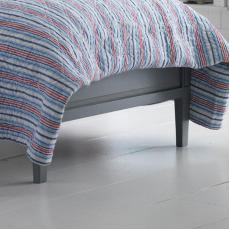
Like many of us, your child can exhibit an allergic reaction to a variety of substances found in and around your home. Typical allergy symptoms include itching, sneezing, runny nose and watery eyes. In many cases, these allergies will remain with your child until adulthood, though with a few simple changes you can significantly reduce the impact of allergies and help your child enjoy a happy, normal life.
Bedding related allergies can cause other problems. According to Judith Owens, M.D., director of sleep medicine at Children's National Medical Centre, in Washington, the symptoms of sleep-deprivation and ADHD mirror each other almost exactly.” If your child is not sleeping well, there’s no two ways about it – you have to take action.
One of the most common allergies for people of all ages is house dust mites. These tiny mites exist wherever humans live, and contain potent digestive enzymes that cause allergic reactions. They thrive in warm places with high humidity, most typically upholstered furniture and carpets.
If your child is suffering from allergies that seem worse at night, you should always seek a professional opinion from your GP in the first instance, though the likelihood is that it’s related to either house dust mites, bed bugs or both. Your GP might suggest a few changes that could be made to your child’s bed in order to reduce or remove these allergy triggers, and we’ve outlined a few of these things below:
- As with everything, choosing quality organic cotton bedding from a reputable company can also help by improving overall sleep quality. Breathable organic cotton sheets are also known to be hugely beneficial to babies and children suffering from eczema and similar skin conditions.
- Wash your child’s bedding weekly at 40c or higher and, where possible, tumble dry them for at least 30 minutes. Use the mildest detergents you can get your hands on and be careful not to overdose, as this could build up on the fibres and end up doing more harm than good.
- Opt for tightly-woven cotton where possible; this will help keep your child cool at night. Moisture from sweat creates a thriving environment for dust mites. Similarly, opt for the best quality, breathable pajamas for your children.
There are additional things you can do to help reduce the impact of dust mites and bed within the area surrounding your child’s bed:
- Bed bugs and house dust mites thrive amongst clutter, so keep the area around your child’s bed as clear as possible and clean all surfaces regularly.
- Use strong-smelling essential oils such as lavender, eucalyptus or tea tree. These will help kill and repel bed bugs. Aromatherapy diffusers or special oil lamps look great and also serve a function – they may end up repelling other insects, too.
- Replace carpet with laminate or wood flooring. Carpets are a breeding ground for dust mites, so if possible remove it from your child’s bedroom. If necessary, add a charming rug instead for warmth.
- Use a vacuum cleaner with a high particulate air filter (HEPA); these trap more dust mites than regular vacuum cleaners so might be worth the investment. Make sure you’re vacuuming regularly to avoid dust from accumulating over time.
- Clean cushions, soft toys, and curtains by washing at a high temperature and regularly vacuuming. We know it’s difficult, but soft toys can be germ factories and need to be kept hygienic – even if it means prying them from your child’s hands!
Allergies can be particularly frustrating to deal with when they happen to children, but thankfully bedding-related allergies are some of the easiest to address. It may take a little trial and error, and you may need to invest in new linen, but the results are worth it: a good night’s sleep for your child.
By taking these few simple steps you can make a big difference to your child’s quality of life by significantly reducing the number of triggers that cause allergic reactions both within their bed and the surrounding areas. As always, consult with your doctor if you’re unsure.
